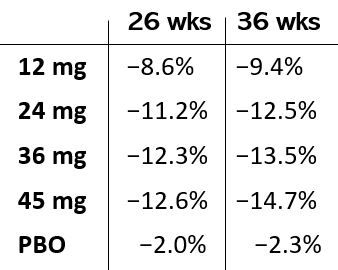- Clinical Technology
- Adult Immunization
- Hepatology
- Pediatric Immunization
- Screening
- Psychiatry
- Allergy
- Women's Health
- Cardiology
- Pediatrics
- Dermatology
- Endocrinology
- Pain Management
- Gastroenterology
- Infectious Disease
- Obesity Medicine
- Rheumatology
- Nephrology
- Neurology
- Pulmonology
Oral GLP-1 Agonist Orforglipron Leads to ~15% Mean Body Weight Reduction in Adults with Overweight/Obesity
Couresty Wharton Medical Clinic

The novel nonpeptide oral glucagon-like peptide-1 (GLP-1) receptor agonist orforglipron was associated with weight loss of nearly 15% in adults with obesity or overweight and without type 2 diabetes (T2D) according to results of a phase 2 dose-finding clinical trial presented Friday, June 23, 2023 at the 83rd Scientific Sessions of the American Diabetes Association (ADA).
"We recognize that obesity is a global epidemic and there is a need for a variety of effective medications and administration routes," said first author Sean Wharton, MD, PharmD, medical director at Wharton Medical Clinic in Toronto, Ontario, Canada. Wharton and colleagues, writing in the New England Journal of Medicine, point out that at this stage of the evolution in pharmacotherapy for overweight and obesity, “there is an unmet need for an oral, incretin-based therapy with efficacy similar to that of injectable GLP-1 receptor agonists.”
An option with this profile may help increase acceptance of and adherence to treatment given the ease of use, they added. The current trial results indicate that "orforglipron may be an effective, once-daily oral that can be taken without food or water restrictions."*
Methods
Wharton and colleagues enrolled participants in Canada, the US, and Hungary between 18 and 75 years of age who did not have T2D (HbA1c <6.5%) and had obesity or overweight plus at least 1 of the following weight-related comorbidities: hypertension, dyslipidemia, cardiovascular disease, or obstructive sleep apnea. Eligible participants also were required to have maintained a stable body weight for the 3 months before treatment assignment.
Participants were assigned randomly to receive orforglipron at a dose of 12 mg, 24 mg, 36 mg, or 45 mg or placebo once daily by oral capsule in the morning but without restrictions on timing of a morning meal for 36 weeks. Investigators further divided the 36- and 45-mg dose cohorts into 2 subcohorts assigned different starting doses and dose-escalation schemes. Final randomization, including these subcohorts, was performed in a 5:5:3:3:3:3:5 ratio.
The 40-week trial period comprised a screening and lead-in period of 2 weeks followed by 36 weeks of treatment, and a 2-week period of follow-up. Participants in all orforglipron treatment groups received escalating doses for up to 16 weeks, depending on cohort, according to the study, and all active treatment groups had a starting dose of 2 mg or 3 mg.
The investigators defined the study's primary endpoint as percentage change in body weight from baseline to week 26. Secondary endpoints were the percentage change from baseline in bodyweight at week 36; absolute change from baseline in body weight, BMI, and waist circumference at week 26 and week 36; and weight reductions of at least 5% and at least 10% by week 26 and week 36. Two exploratory endpoints were included as well: weight reduction of at least 15% by week 26 and week 36.
FINDINGS
Wharton and colleagues enrolled 272 participants from September 2021 through November 2022. The cohort had a mean age of 54.2 years, was 59% women, and 91% White. Mean baseline body weight was 108.7 kg, and mean BMI 37.9.
At week 26 (primary endpoint) and week 36 (secondary endpoint), the authors reported statistically significant dose-dependent body weight reductions for all doses with estimated mean change from baseline as follows:

Weight reduction of at least 10% by 26 weeks was seen in up to 71% of participants who received orforglipron, according to the study. All 4 doses of the investigational drug met all investigators' key secondary endpoints at 36 weeks for the efficacy estimand, including:
- Body weight reductions of ≥5%: 72% (12 mg), 90% (24 mg), 92% (36 mg) and 90% (45 mg) compared to 24% with placebo
- Body weight reductions of ≥10%: 47% (12 mg), 62% (24 mg), 75% (36 mg) and 69% (45 mg) compared to 9% with placebo
- BMI reduction from baseline: 3.4 kg/m2 (12 mg), 4.7 kg/m2 (24 mg), 5.0 kg/m2 (36 mg) and 5.5 kg/m2 (45 mg) compared to 0.9 kg/m2 with placebo
- Waist circumference reduction from baseline: 9.6 cm (12 mg), 11.2 cm (24 mg), 10.6 cm (36 mg) and 13.6 cm (45 mg) compared to 4 cm with placebo
Findings from the safety analysis for orforglipron reflect profiles of other incretin-based therapies, ie, gastrointestinal side effects were the most commonly reported adverse events and were mild-to-moderate in severity, according to the study. Most adverse events occurred during the dose escalation period, were transient and resolved without discontinuation of the study drug or placebo. The most frequent gastrointestinal events did not increase in a dose-dependent manner with orforglipron doses higher than 3 mg.
In the study's discussion, Wharton et al wrote, "Despite the relatively short trial period, the weight loss observed in this trial was similar to that observed with injectable GLP-1 receptor agonists that have been approved for weight management." Given that weight loss had not reached a plateau at the 36-week point, they continued, it's possible that longer treatment duration will result in additional reduction in body weight.
They also emphasize that the magnitude of the weight loss recorded with orforglipron is in line with "current recommendations for weight reduction that is expected to result in improvement in many obesity-associated coexisting conditions.
"Further studies are needed to establish whether the health benefits seen with injectable GLP-1 receptor agonists are shared by orforglipron."
(*Oral semaglutide, explained Wharton et al, approved for T2D, and now being investigated at higher doses to treat obesity and uncontrolled T2D, uses an absorption enhancer to enable absorption in the stomach and is effective only when taken 30 minutes prior to food consumption.)
Reference: Wharton S, Blevins T, Connery L, et al. Daily oral GLP-1 receptor agonist orforglipron for adults with obesity. N Enlg J Med. Published online June 23, 2023. doi:10.1056/NEJMoa2302392
